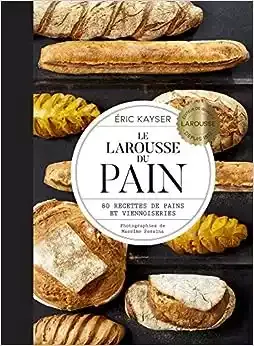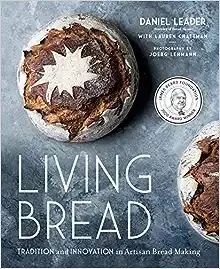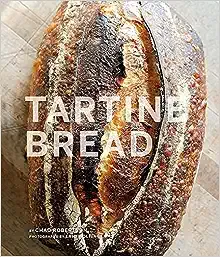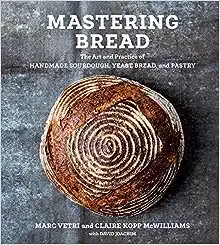15 Best Bread Cookbooks of All Time
The best bread cookbooks of all time are a terrific place to start your collection if you're merely searching for books to help you get better at baking bread.
Must see‼ ️15 recommended bread books! Bread from beginner to advanced!
Once you get into baking, it’s as deep as the sea, and you want to learn all kinds of delicious breads, desserts, and cakes.
Reading bread-baking books is a particularly efficient way of learning! Today is a list of must-read bread cookbooks for bakers!
Some of the top recommended bread cookbooks include The Bread Baker's Apprentice by Peter Reinhart, Flour Water Salt Yeast by Ken Forkish, Brilliant Bread by James Morton, and Bread Baking for Beginners by Bonnie Ohara.
Best Bread CookBooks from Beginner to Advanced!
The world of baking is vast, and when you step into it, you will be deeply impressed by all kinds of delicious bread, desserts, and cakes.
As a staple food category, bread has always occupied a rare position in bakery products.
I recently saw an article written by the owner of a bakery, telling the story of his development from a small shop of 35 square meters to a "big shop" of 100 square meters.
There is a passage in it that is worth sharing with novices:
"Until a long time later, people will always ask me, how do I open a bakery? Then my answer must be: first read a lot of books to have a basic theoretical framework, and then find a good teacher to guide you. Finally, practice it over and over again.”
Sometimes we patronize hands-on practice, ignoring the basic knowledge. When we fail, we don’t know the reason or how to correct it. We can find all kinds of answers on the Internet.
It’s better to take the time to read and study carefully, absorb the excellent experience compiled by the predecessors, and bake It will also get twice the result with half the effort!
"But there are so many bread books? Which one should I read?"
Next, the Editor will share with you a few theoretical books about bread baking, from dough fermentation to master recipes, from famous shop decoration to world-class business ideas, Slow down and understand the details, and you can also become a new generation of bread masters!
I recommend these 15 best bread books for beginners to you, which will definitely make you crazy about bread!
Paul Hollywood Bread Making Books
Paul Hollywood is probably the king of bread making, having made his name on The Great British Bake Off and having his own bread-themed BBC TV show.
Paul began baking in his family bakery as a child and went on to work in some well-known restaurants across the UK.
His breadmaking experience is invaluable and his books are a must-have for breadmakers and bakers of all levels. Here are my top three picks from Paul Hollywood.
1. Paul Hollywood's bread
Paul Hollywood's 'Bread Book' accompanies his BBC show which covers bread recipes, bread-making tips, recipes to pair with bread, and recipes using bread as the main ingredient.
Perfect for: Bakers who want more than just bread recipes.
Paul Hollywood's new book is all about bread - how to make it and how to use it.
Not only does Paul teach you exactly how to make a variety of breads, but for each one there is a spin-off recipe that shows you how to make a fantastic meal of it.
The book has six chapters, each with five bread recipes - plus the spin-off recipes for main courses.
Not only are Paul's recipes delicious but they are also foolproof, with comprehensive step-by-step photographs.
- Try your hand at a basic white bloomer, which can become a savory picnic loaf;
- stilton and bacon rolls, which are excellent served with celery soup;
- fluffy crumpets, which become the base for eggs Benedict;
- spinach does, which is a natural pairing with chickpea masala;
- ciabatta, which the Italians have traditionally used as a base for tomatoey panzanella;
- pizza bases, which can become home-made fig, Parma ham, and Gorgonzola pizzas; or
- white chocolate and raspberry bread, which makes for the best bread pudding you've ever tasted.
2. How to Bake by Paul Hollywood
Paul Hollywood's How to Bake is all about how to bake, and about half of the book is devoted to bread recipes, tips, and tricks.
The other half is dedicated to cake and pastry recipes. This is a real go-to book for basic baking techniques.
Perfect for: Bakers who want to improve their breadmaking skills and want to mix up their baking recipes.
Paul Hollywood was the son of a baker long before he became a household name as a judge on The Great British Baking Show.
Raised to make perfect bread, scones, and sponges, he advanced from his father's kitchen to become head baker at hotels around the world.
As he worked, Hollywood became passionate about busting the myths that surround baking, sharing his finely honed skills, and showing that with the right guidance, anybody can achieve success time after time.
Now, in How to Bake, Hollywood introduces readers to his tried and true techniques.
He has filled this book with easy-to-follow, clearly explained, utterly delicious recipes for an abundance of bread, pastries, cakes, and biscuits from ciabatta to focaccia and fresh croissants to a classic Victoria sponge.
3. Paul Hollywood's 100 Bread
Paul Hollywood's 100 Delicious Breads showcases a variety of bread recipes, including traditional, Mediterranean, and ancient bread.
Offers recipes for savory and sweet breads as well as the experience and techniques of the master baker himself.
Paul Hollywood conveys his love of bread-making in this collection of fantastic recipes.
Good for: Beginner bread makers looking for bread-making tips and recipes.
4. Brilliant Bread by James Morton
From Paul Hollywood to James Morton. James was a finalist in the 2012 British Bake Off series.
His book Brilliant Bread makes bread-making look easy, and the easy tips and recipes he follows are perfect for bread-making beginners.
Good for: Bread-making beginners and those who prefer a step-by-step approach.
James Morton was surely the people's favorite to win 2012's Great British Bake Off series—with his Fairisle jumpers and eccentric showstoppers, this soft-spoken Scottish medical student won the viewers' hearts, if not the trophy.
James's real passion is bread-making. He is fascinated by the science of it, the taste of it, the making of it. And in Brilliant Bread he communicates that passion to everyone, demystifying the often daunting process of "proper" bread making.
James uses supermarket flour and instant yeast—you can save money by making your own bread. You don't even have to knead! It just takes a bit of patience and a few simple techniques.
Using step-by-step photos, James guides the reader through the how-to of dough making and shaping, with recipes ranging from basic loaves to flatbreads, sourdoughs, sweet doughs, buns, doughnuts, focaccia, and pretzels.
Inspiring and simple to follow, with James's no-nonsense advice and tips, this book will mean you never buy another sliced white loaf again.
5. The Handmade Loaf: The book that started a baking revolution by Dan Lepard
Dan Lepard is an Australian baker and celebrity chef with a passion for bread making.
His book Artisanal Bread is all about bread and is filled with bread recipes from around the world.
Dan shares his unique tips and tricks on how to make the best and most delicious bread.
Perfect for: Home bakers who are looking to make artisan breads and perfect their skills.
With more than 75 recipes, from dark crisp rye bread and ricotta breadsticks to effortless multigrain sourdough, The Handmade Loaf guides you through the stress-free techniques you need to make and bake great bread at home.
Made and photographed in kitchens and bakeries across Europe, from Russia to the Scottish Highlands, Dan Lepard's ground-breaking methods show you how to get the most flavor and the best texture from sourdough and simple yeast bread with minimal kneading and gentle handling of the dough.
Let this classic cookbook guide you to making superb bread at home.
6. Flour Water Salt Yeast: The Fundamentals of Artisan Bread and Pizza [A Cookbook] by Ken Forkish
Ken Forkish is an award-winning American baker and food writer.
In his book Flour Water Salt Yeast, he teaches his readers how to make perfect bread and pizza dough. as well as the science needed to make the best dough, and shows you how to make your own custom dough.
Master Ken said:
"In my opinion, the real skill of baking bread lies in using only 4 basic ingredients."
This is a comprehensive tutorial that helps us understand bread from its essence - combining the four basic ingredients of flour, water, salt, and yeast.
The raw materials are used to the extreme. After reading this book, we can know the key details that may be overlooked in daily bread making, truly grasp the essence of bread, make fewer detours and make fewer mistakes, and make good bread in one step.
Perfect for: Artisan bread makers and bread-making beginners looking to improve their skills.
- Recognized by the baking industry as a must-read classic for making top artisan bread and pizza!
- After the author has personally researched and adjusted the formula, beginners can make top artisan bread and pizza in their own kitchen as long as they use cast iron pans, ovens, and simple utensils and follow the steps!
7. Bread Baking for Beginners: The Essential Guide to Baking Kneaded Breads, No-Knead Breads, and Enriched Breads by Bonnie Ohara
Bonnie Ohara's Bread Making for Beginners is specifically aimed at those who are new to bread making and are looking for simple step-by-step instructions.
This book helps you figure out the science behind bread making, teaches you the basics of making good bread, and helps you solve common bread-making mistakes.
Perfect for: Beginners looking for step-by-step instructions on the basics of bread making.
8. The Bread Baker's Apprentice: Mastering the Art of Extraordinary Bread by Peter Reinhart
It was once one of the best-selling books on baking on Amazon, and it was also extremely popular in the baking circle!!!
There are many classic bread recipes in the book, which are rich in content, clearly explained, and also have step-by-step diagrams, so you can follow along to make them!!!
It is a book about professional and home baking, with various tips and techniques taught.
Highlights:
- The author shared with us the essence he absorbed from bread
- You can make all 50 classic Western recipes together
- Peter Reinhart is a co-founder of the legendary Juniper Brothers Bakery, an instructor at a world-class baking academy, and has led the American artisanal dough movement for 30 years.
- Peter blends scientific knowledge, advanced technology, and food history to distill knowledge that is accessible and engaging to everyone, and makes it as rich and layered as baked bread.
I recommend it because it is not only suitable for professional bakers, but also very friendly to home bakers. The whole book also talks about many processing methods suitable for home baking.
9. Professional Baking by Wayne Gisllen
The book has 26 chapters in total, combining theory with practice! Covering all aspects of baked goods, the theoretical part is explained in simple terms, and the practical part has more than 900 methods and recipes for making baked goods!
- This book is written by the International Association of Culinary Professionals (IACP) award-winning best-selling author Wayne Gieslen.
- From baking history, professional basic skills, baking principles, baking ingredients and utensils to bread, cakes, tarts, pies, cookies, mousse, pudding, chocolate, sugar art, frosting, plate desserts, frozen desserts, dessert assembly, Special dietary baked goods preparation, etc.
10. Bread and Butter: History, Culture, Recipes by Richard Snapes, Grant Harrington
50 detailed recipes, covering bread, butter, combining bread and butter, and making leftover bread; it also introduces the history, origin, and culture of 49 mainstream breads and 14 specialty butters around the world!
- The first contextualized cookbook! The background of the creation of the recipes, the scenes and feelings of making food, and the detailed recipes will make you feel as if your grandmother is teaching you how to cook food step by step.
- The whole book is printed on offset paper. The pictures in the book have a texture like oil paintings. They not only reflect the details of the food but also restore the realistic production process.
11. Le Grand Livre de la Boulangerie (French Edition) by Jean-Marie Lanio, Thomas Marie
Covers 100 traditional French breads and the precise production methods of delicious breads in the world! The content is professional and worthy of every food lover!
- Written by masters of the National Bakery Institute of Lyon (INBP) and French Bread MOF, both of which have numerous professional bakers. Many years of teaching experience are shared without any secrets, so you can learn everything in one go.
- Detailed material ratio, clear production steps, high-definition physical photos, and simple and intuitive grasp of different methods of different pieces of bread.
- It integrates knowledge, professionalism, appreciation, learning, reference, and collection. The baking skills necessary for bakers are all included so that the doubts in the production will be hidden.
12. Le Larousse du Pain by Eric Kayser
World baker Eric Kaiser's classic bread recipes and unique techniques come with a "Bread Making List", so you can bake classic bread from world-famous stores with your own hands!
- Covers more than 100 methods of making natural yeast bread, improving traditionally baked bread on the basis of classic yeast bread-making recipes.
- With failure cases, various common problems in baking are explained in detail. It is suitable for novices to practice and can also be used as a baking guide for professional bakers.
13. Living Bread: Tradition and Innovation in Artisan Bread Making by Daniel Leader, Lauren Chattman
In the current epidemic situation, how can I learn the techniques and recipes of artisan bread from other countries without leaving home?
The author of this book, Daniel Leader (Daniel Leader) has traveled all over the world for 40 years, visited countless bread masters, introduced the best bread he has ever tasted to readers, and modified it with his unique formula and production method. 60 classic styles of European bags can also be made.
During the decades of traveling around the world, the author has learned from bakers from all over the world, from tradition to innovation, from style to taste.
This book has photos and detailed production instructions related to contemporary bread baking so that baking lovers can easily learn at home, re-engraving the classic taste.
From the cultivation method of wheat, the production of flour, and the fermentation of dough to the machinery used in baking, this book should give an overview.
In a word, this book is a love letter to "good bread" in the new era, and also an epoch-making guide to the baking industry.
This book is a bit pricey, but it was worth it when I received it. The pages, printing, and pictures are all beautiful. In addition to recipes, the author also shared many bakers' stories and experiences in making bread.
14. Tartine Bread by Chad Robertson
Chad Robertson What kind of bakery has no sign but long queues every day? The bread is so delicious that it has become a pilgrimage spot for bread lovers around the world.
The bread is sold out immediately after it is baked? Tartine Bakery was once hailed as "the best bakery in America" by Time Magazine's food column, and its Tartine Bread was called "the most beautiful bread recipe" by the New York Times.
For store manager and owner Chad Robertson, making bread is more like an interesting experiment, not just measuring room temperature and recipe proportions, but also requiring eyes, ears, mouth, and nose to work side by side.
In this book, the author turns his years of "fermentation" experience into words and pictures, which are detailed and popular.
These include the method of making yeast, the choice of flour, and the technique of turning the dough.
There are also croissant, brioche, and even pizza recipes based on the basic bread, as well as more than 40 classic soups and sandwiches made with bread, salads, and other delicious dishes, let alone talking about them, My mouth is watering just thinking about them. I have to quickly browse through them to see what I will eat for dinner!
15. Mastering Bread: The Art and Practice of Handmade Sourdough, Yeast Bread, and Pastry
The Vetri Cucina Bread Program began over a decade ago and has been part of the American movement to reclaim high-quality bread as a cornerstone of our food culture.
In Mastering Bread, Marc Vetri and his former head baker, Claire Kopp McWilliams, show home cooks how to create simple bread with unique flavors in a home oven.
Included are more than seventy recipes for their bestselling sourdough and yeast loaves as well as accompaniments to serve with the breads.
Their process of bread-making is broken down into three easy-to-digest chapters: Mix, Shape, and Bake. Another chapter includes recipes for enjoying bread in dishes such as Bruschetta, Panzanella, and Ribollita.
There’s even a bonus chapter revealing the secrets of Vetri’s coveted Panettone. This book shares everything that Vetri and McWilliams have learned over the years about the art and science of making incredible bread.
They explain how to use fresh milled and whole-grain flour as well as local and regional wheat varieties, with easy instructions for adapting bread recipes for success with whatever flour is available in your market.
Included throughout are bios and interviews with grain farmers, millers, and breadmakers from around the nation.
Mastering Bread is a master class from an award-winning chef who makes world-class artisan bread easy to bake for both home cooks and professionals alike.
Conclusion: Best Bread CookBooks for Your Kitchen Library
To be honest, there are quite a lot of bread cookbooks on the market. These books are the most recommended. Many plastic surgery diagrams are very detailed, and they are also very practical books.
As we all know, making bread well is inseparable from practical operations. If you want to make bread thoroughly and finely, it is important to clarify your goals and settle down to learn with great concentration.
I strongly recommend the above bread cookbooks that I feel are very practical after reading.
The main thing is to enjoy the baking process and, most importantly, enjoy eating something delicious knowing that you made it!
Book Recommender
LOOKING FOR MORE BOOKS TO READ?
Explore and find your next good read - Book Recommender for specific interests.
Discover ratings, reviews, summaries, and genres from Google Books.
Get Book Suggestions

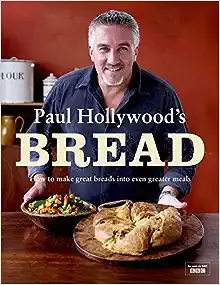

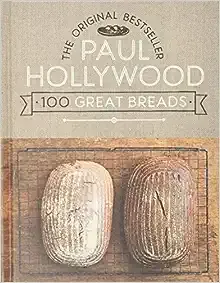


![Flour Water Salt Yeast: The Fundamentals of Artisan Bread and Pizza [A Cookbook] by Ken Forkish best-bread-cookbooks](https://blogger.googleusercontent.com/img/b/R29vZ2xl/AVvXsEjbVNrO10ffLi1cHdgRBQReTVv2283deHKkPTqdYL3eWNgF01w98SlowG9WMRLpTCPpT7eAq1WtBKbk8rPYNiZ0SN5t9w0eQJjbskqXZ3jbMgw-soJnRiylOHoOI8N7RyvQUUpeZ1V-_zXqsJYYVviWidnF3TAH93h2izn6oHjqbx9Nz9seAbYXoEuIUkU/w322-h400-rw/Flour%20Water%20Salt%20Yeast.webp)





